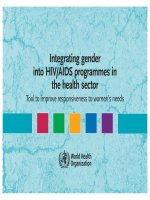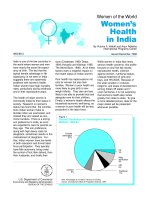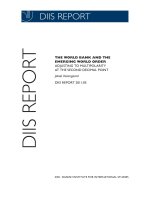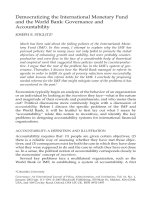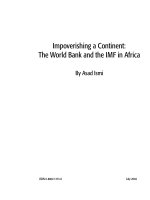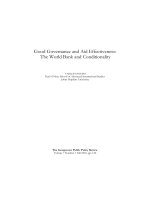Integrating Gender into the World Bank’s Work: A Strategy for Action potx
Bạn đang xem bản rút gọn của tài liệu. Xem và tải ngay bản đầy đủ của tài liệu tại đây (246.97 KB, 92 trang )
Integrating Gender into
the World Bank’s Work:
A Strategy for Action
The World Bank
January 2002Water and the Moon
In South Africa, an estimated 16 million people have no oper-
ating water supply, with their source of water an average of 1
km away. If the average household is 5 persons, that makes 3.2
million households. If two trips to fetch water are made each
day at a round-trip distance of, conservatively, 2 kms each, that
makes a distance of 12.8 million km walked each day, day after
day, by South African women, just to fetch water. If the aver-
age distance to the moon is 384,400 km, South African women
walk a distance equivalent to the moon and back 16 times a
day just to fetch water (or 319 times around the Earth’s equa-
tor). If each trip takes an average of 1 hour to walk to the
place, wait in a queue, collect the water, and walk back, 6.4
million trips take 6.4 million hours a day—at 8 hours a day, 21
working days a month, 11 months a year, this represents near-
ly 3,500 working years each day fetching water. This is just
South Africa. If you think of the rest of Africa, it is staggering—
and this for only about 10 litres of water each, which is usual-
ly of suspect quality.
Source: www.thewaterpage.com
iiiTable of Contents
Acronyms and Abbreviations . . . . . . . . . . . . . . . . . . . . . . . . . . . .viii
Preface . . . . . . . . . . . . . . . . . . . . . . . . . . . . . . . . . . . . . . . . . . . . . . .ix
Executive Summary . . . . . . . . . . . . . . . . . . . . . . . . . . . . . . . . . . . . .xi
1. The Business Case for Mainstreaming Gender . . . . . . . . . .1
The Empirical Links of Gender to Poverty and Growth . . . . . 4
Gender Equality and Growth . . . . . . . . . . . . . . . . . . . . . .4
Gender and Poverty Reduction . . . . . . . . . . . . . . . . . . .10
Gender and Development Effectiveness . . . . . . . . . . . . .11
Gender Disparities in Developing Countries . . . . . . . . . . . .12
Opportunities for Gender Mainstreaming in the Bank . . . . .13
2. The Strategy . . . . . . . . . . . . . . . . . . . . . . . . . . . . . . . . . . .17
The Basic Process . . . . . . . . . . . . . . . . . . . . . . . . . . . . . . . . . .19
Country Gender Assessment . . . . . . . . . . . . . . . . . . . . .19
Dialogue and Action . . . . . . . . . . . . . . . . . . . . . . . . . . .22
Projects . . . . . . . . . . . . . . . . . . . . . . . . . . . . . . . . . . . . .25
Internal Actions to Facilitate the Basic Process . . . . . . . . . . .25
Integrating the Gender Dimension into
Relevant Analytical Work and Quality Assurance . . . . .26
Supporting the Strategic Integration
of Gender Issues into Operations . . . . . . . . . . . . . . . . .28
Aligning Resources with Strategy Elements . . . . . . . . . .30
Monitoring and Evaluation . . . . . . . . . . . . . . . . . . . . . .34
Implementation Timetable . . . . . . . . . . . . . . . . . . . . . . . . . .34
v
INTEGRATING
GENDER INTO THE WORLD BANK’S WORK
3. Toward a Framework for Prioritizing Gender Issues . . . . .41
Gender Mainstreaming . . . . . . . . . . . . . . . . . . . . . . . . . . . . .41
Toward a Framework . . . . . . . . . . . . . . . . . . . . . . . . . . . . . . .46
4. Challenges to Gender Mainstreaming . . . . . . . . . . . .55
Adequacy of the Existing Policy Framework . . . . . . . . . . . . .55
The Bank’s Track Record . . . . . . . . . . . . . . . . . . . . . . . . . . . .57
5. The Bank’s Comparative Advantage
in Gender and Development . . . . . . . . . . . . . . . . . . . . . .61
How the Bank is Positioned vis-à-vis other
Donors and Service Providers . . . . . . . . . . . . . . . . . . . . . . . .62
Partnerships . . . . . . . . . . . . . . . . . . . . . . . . . . . . . . . . . . . . . .64
Internal Bank Group Synergies: The International
Finance Corporation . . . . . . . . . . . . . . . . . . . . . . . . . . . . . . .66
Bibliography . . . . . . . . . . . . . . . . . . . . . . . . . . . . . . . . . . . . .69
Annex
Management Response to the Recommendations of the
Operations Evaluation Department’s Gender Reviews . . . . .73
Boxes
1.1 The Definition of Gender . . . . . . . . . . . . . . . . . . . . . . . . . . . 2
1.2 The Millennium Development Declaration,
the Beijing Platform for Action, and CEDAW . . . . . . . . . . . . 3
1.3 World Bank Operational Policy 4.20:
The Gender Dimension of Development . . . . . . . . . . . . . . .14
2.1 The Country Gender Assessment . . . . . . . . . . . . . . . . . . . . . .21
2.2 Good Practice Example: Integration of Gender
Analysis into a World Bank Country Assistance
Strategy and Analytical Work . . . . . . . . . . . . . . . . . . . . . . . . .23
2.3 Good Practice Examples: Gender Mainstreaming
in Adjustment and Programmatic Lending . . . . . . . . . . . . . .27
VI
3.1 Good Practice Example: A Crosscutting Approach
to Gender Mainstreaming . . . . . . . . . . . . . . . . . . . . . . . . . . .43
3.2 Links between Gender and Productivity:
Gender and Agriculture in Zambia . . . . . . . . . . . . . . . . . . . .48
3.3 Key Questions for Assessing Gender-Related
Obstacles to Development . . . . . . . . . . . . . . . . . . . . . . . . . . .50
4.1 Evolution of the Bank’s Attention to Gender
and Development Issues . . . . . . . . . . . . . . . . . . . . . . . . . . . .58
Figure
5.1 World Bank Priorities . . . . . . . . . . . . . . . . . . . . . . . . . . . . . .63
Tables
2.1 Organizational Responsibilities for
Gender Mainstreaming . . . . . . . . . . . . . . . . . . . . . . . . . . . . .35
2.2 Implementation Timetable . . . . . . . . . . . . . . . . . . . . . . . . . .39
TABLE OF CONTENTS
VII
INTEGRATING
GENDER INTO THE WORLD BANK’S WORK
Acronyms and Abbreviations
CAS Country Assistance Strategy
CDF Comprehensive Development Framework
CEDAW Convention on the Elimination of all Forms of
Discrimination against Women
CGA Country Gender Assessment
FHH Female-Headed Household
IBRD International Bank for Reconstruction and
Development
IDA International Development Association
IFC International Finance Corporation
IMF International Monetary Fund
I-PRSP Interim Poverty Reduction Strategy Paper
JSA Joint Staff Assessment (World Bank and IMF)
NGO Non-governmental Organization
OECD Organisation for Economic Co-operation and
Development
PRSP Poverty Reduction Strategy Paper
UN United Nations
UNDP United Nations Development Programme
UNESCO United Nations Educational, Scientific and Cultural
Organisation
UNICEF United Nations Children’s Fund
UNIFEM United Nations Development Fund for Women
VIII
Preface
his volume presents a strategy for mainstreaming gender-
responsive actions into the development assistance work of
the World Bank. The strategy was approved by the Bank’s sen-
ior management on April 13, 2001, was discussed by the
Bank’s Board of Executive Directors Committee on Development Effec-
tiveness on May 9, 2001, and was endorsed by the full Board of Execu-
tive Directors on September 18, 2001.
The strategy was developed in recognition of the desirability of
finding more effective ways to integrate gender-responsive actions into
the World Bank’s development assistance. The Bank’s Gender and
Development Board (a Bank-wide body composed of representatives
from the main operational units in the Bank) took the lead in devel-
oping the strategy and was the primary sounding board for drafts of the
paper, which were written by a team headed by Karen Mason, Director
of Gender and Development, that included Cecilia Valdivieso, Susan R.
Razzaz, C. Mark Blackden, Lucia Fort and Helene Carlsson. Production
of the printed version was enabled by Sarah Nedolast, Susan Giebel
Suoninen, Deborah Davis, and Beni Chibber-Rao.
Extensive consultations were held inside and outside the Bank as
the strategy was being developed. The Bank’s External Gender Consul-
tative Group offered comments on several drafts; consultative work-
shops with government officials and members of civil society were
ix
T
INTEGRATING
GENDER INTO THE WORLD BANK’S WORK
held in the six regions in which the Bank works; and informal consul-
tations were held with many of the Bank’s bilateral donor partners and
representatives from UN agencies. The Bank is grateful to their partners
in development for helping to make the strategy more responsive to
the needs of women and men throughout the world.
X
Executive Summary
everal major World Bank reports provide strong empirical evi-
dence that the gender-based division of labor and the
inequalities to which it gives rise tend to slow development,
economic growth, and poverty reduction.
I
Gender inequali-
ties often lower the productivity of labor, in both the short term and
the long term, and create inefficiencies in labor allocation in house-
holds and the general economy. They also contribute to poverty and
reduce human well-being. These findings make clear that gender
issues are an important dimension of the fight against poverty. Gen-
der issues are also central to the commitments made by the World
Bank’s member countries at the United Nations Millennium Summit
and at the Fourth World Conference on Women in Beijing in 1995.
Although the nature and importance of gender issues for poverty
reduction and growth vary from country to country, significant gen-
der disparities are found in all regions of the world (including in the
member countries of the Organisation for Economic Co-operation
and Development—OECD). These disparities tend to be greater in
low-income than in higher-income countries, and, within countries,
tend to be greater among the poor than the more affluent. The incor-
poration of gender issues into development actions needs to be sen-
sitive to the specific conditions in each country.
xi
I
Engendering Development—Through Gender Equality in Rights, Resources, and Voice, 2001a;
World Development Report 2000/2001: Attacking Poverty, 2000d; and Voices of the Poor: Can
Anyone Hear Us?, Narayan et al, 2000.
S
INTEGRATING
GENDER INTO THE WORLD BANK’S WORK
Since the 1980s, the Bank has made progress in integrating gen-
der issues into country work and lending, particularly in education
and health. For example, between 1995 and 2000 the Bank lent
more than $3.4 billion for girls’ education programs, and was also
the single largest lender in the world for health, nutrition, and pop-
ulation projects, three-quarters of which contained gender-respon-
sive actions. Attention to gender issues in World Bank Country
Assistance Strategies (CASs) also increased during this period. Sever-
al organizational changes designed to facilitate greater attention to
gender and development issues were also made, including issuing an
Operational Policy on the gender dimension of development in
1994, and creating a Gender and Development Board and placing it
within the Poverty Reduction and Economic Management Network
in 1997.
Despite the progress to date in gender mainstreaming, the
Bank’s effectiveness can be improved by paying more systematic and
widespread attention to gender issues in the context of its poverty
reduction mandate. The opportunities for improving the develop-
ment impact of the Bank’s work through gender mainstreaming
include making Bank interventions more responsive to country gen-
der conditions and commitments; making these interventions more
strategic; and improving the alignment of Bank policies, processes,
and resources to support such interventions.
In the strategy described in this paper, the World Bank will
work with governments and civil society in client countries,
and with other donors, to diagnose the gender-related barriers to
and opportunities for poverty reduction and sustainable
development; and will then identify and support appropriate
actions to reduce these barriers and capitalize on the oppor-
tunities.
The strategy is intended to establish an enabling environment
that will foster country-led, country-specific strategies for changing
the gender patterns that are costly to growth, poverty reduction, and
human well-being. The strategy rests on a basic process that involves
working with countries to:
XII
• prepare periodic, multi-sectoral Country Gender Assessments
(CGAs) that analyze the gender dimensions of development
across sectors and identify gender-responsive actions important
for poverty reduction, economic growth, human well-being,
and development effectiveness, and which inform the Bank’s
country assistance program;
• develop and implement, as part of the Bank’s country assistance
program, priority policy and operational interventions that
respond to the assessment; and
• monitor the implementation and results of these policy and
operational interventions.
A key component of the strategy is the CGA, a country-level
gender analysis that identifies critical areas in which gender-respon-
sive actions are likely to enhance growth, poverty reduction, and
well-being in a particular country context. Country Directors will
ensure the completion of these assessments in a timely manner in
countries with an active lending program (and in which an assess-
ment has yet to be conducted). In line with the ongoing reform of
the Bank’s analytical work, the methods for carrying out these assess-
ments will be flexible. The country gender analysis may, for example,
be a stand-alone document or a section of a country poverty or eco-
nomic analysis. The CGA may contain original, analytical work or
may simply refer to such work produced by the Bank or by other
agencies (government, international, academic). To lower costs,
increase buy-in, and build on expertise outside the World Bank, col-
laboration with government, civil society, and other donors in com-
pleting the CGA will be emphasized when possible. Management,
with the assistance of the Gender and Development Board, will clar-
ify standards for conducting the assessments and monitoring their
quality. Updates will be done in accordance with the typical cycle for
country analytical work (approximately once every five years), and
will be designed to investigate whether any major changes in gender
EXECUTIVE SUMMARY
XIII
INTEGRATING
GENDER INTO THE WORLD BANK’S WORK
conditions have occurred (i.e., updates will typically be less elaborate
than the initial assessment). When possible, CGAs that contain sub-
stantial original work will be published and shared broadly.
The gender strategy rests on four actions designed to enable the
process of diagnosis, strategy formation, and integration into
operations:
Integrating a gender dimension into relevant analytical work
and lending instruments. An understanding of gender issues in sec-
tors identified in the diagnosis as important for poverty reduction
and growth is a necessary prelude to gender-responsive project
design. Tracking whether analytical work and projects in these sec-
tors have been conducted with a cognizance of key gender issues is
also important for improving performance and quality. For this rea-
son, the strategy recommends integrating a gender dimension into:
• sectoral analytical work in high-priority sectors (as identified in
the CGA), and into the social impact analysis associated with ad-
justment lending (including Poverty Reduction Support Credits);
• the criteria used to assess the poverty reduction focus of Pover-
ty Reduction Strategy Papers (PRSPs) in Joint Staff Assessments
(JSAs);
• the criteria used to assess the adequacy of the poverty reduction
focus of the CAS and Sector Strategy Papers; and
• the quality criteria used by the Quality Assurance Group to
assess projects and analytical work, with appropriate consider-
ation of whether particular sectors have been identified as high
priority in the CGA.
Supporting the strategic integration of gender issues into
operations. The strategy recommends three forms of support for
operations:
XIV
• Training. To assist Bank staff and counterparts in strategically
mainstreaming gender issues into operations, the Gender and
Development Board will work with Human Resources and the
World Bank Institute to add gender and development content
to the Bank’s staff orientation course and to existing core
courses. Selected technical modules oriented to operational
staff will also be developed.
• Operational tools. Together with regional sectoral staff, the
Gender and Development Board will continue to create and
disseminate adaptable tools and good practice examples for use
in operations. Good practice examples, including those involv-
ing macroeconomic policy advice, will be emphasized.
• Building capacity in implementing agencies. The Gender and
Development Board will explore methods to provide technical
advice to implementing agencies. The Board will also work with
the regions and the World Bank Institute to identify and sup-
port training opportunities for clients and counterparts.
Aligning resources with the elements of the strategy. Four
types of resources will be aligned with the strategy:
• Budget. In line with the decision to make gender mainstream-
ing one of the Bank’s Corporate Advocacy Priorities, Bank budg-
et is being redeployed to support gender analysis and
mainstreaming.
• Accountabilities. The responsibilities of Bank staff for gender
mainstreaming are being clarified (Table 2.1). Regional Vice
Presidents will ultimately be accountable for regional results;
they will in turn hold Country Directors and Sector Directors/
Managers accountable for ensuring appropriate integration of
gender issues into country operations. To clarify policies and
procedures, a revised Operational Policy and Bank Procedures
EXECUTIVE SUMMARY
XV
INTEGRATING
GENDER INTO THE WORLD BANK’S WORK
statement on gender and development will be issued after due
consultation with external stakeholders and consideration by
the Executive Board. While these consultations are ongoing,
Management will issue an Operational Memorandum to clarify
the existing gender policy and provide interim guidance on
implementation.
• Staff. Regions will provide in-house technical expertise in gen-
der and development to assist staff in gender analysis and
strategic operational mainstreaming, especially during the ini-
tial years of implementation.
• Partnerships. Because of the valuable resources that other
organizations have to offer and the potential synergies with
Bank-led activities, the strategy also encourages the formation
of country-level partnerships with governments, civil society,
and other donors, especially in the context of particular projects
or programs, including formulation of the PRSPs.
Monitoring and evaluation. Finally, in order to track progress
and enhance learning and quality, an effective system of monitoring
and evaluation that includes assessment of on-the-ground results is
under development. Progress in implementing the strategy will be
reported annually.
The estimated incremental costs of implementing the strategy
will be about $2 million in the current fiscal year, about $3 million
per year in the three subsequent years, and approximately $2.5 mil-
lion per year thereafter. Corporate incentive funding of $0.6 million
has been set side for the current year, and the regions have commit-
ted more than twice this amount as matching Bank budget. Imple-
mentation has thus been fully funded for the current fiscal year.
XVI
Chapter 1
The Business Case for
Mainstreaming Gender
ender equality is an issue of development effectiveness,
not just a matter of political correctness or kindness to
women. New evidence demonstrates that when women
and men are relatively equal, economies tend to grow
faster, the poor move more quickly out of poverty, and the well-being
of men, women, and children is enhanced. This paper outlines a
Bank-wide strategy for integrating gender concerns into the World
Bank’s work. The need for a new strategy arises both from the evi-
dence that gender plays an important role in determining economic
growth, poverty reduction, and development effectiveness, and from
the less-than-systematic integration of gender concerns into the
Bank’s work to date. The strategy recommends that the World Bank
work with governments and civil society in client countries, and with
other donors, to diagnose the gender-related barriers to and opportu-
nities for poverty reduction and sustainable development; and to
then identify and support appropriate actions to reduce these barriers
and capitalize on the opportunities. The overarching goal of the strat-
egy is to reduce poverty by promoting inclusive development. From a
1
G
2
gender perspective, this means ensuring that both women and men
have a voice in the development of their community and country, that
both are able to benefit from the new opportunities that development
brings, that both have access to the resources needed to be productive
members of society, and that both share in a higher level of well-
being. (See Box 1.1 for the definition of gender.)
Greater attention to gender issues is also required by the com-
mitment of the Bank and its member countries to the goals set forth
in the United Nations Millennium Declaration, the Beijing Platform
for Action, and the Convention on the Elimination of all Forms of
Discrimination Against Women (CEDAW), all of which have a
strong gender dimension (Box 1.2).
1
This chapter describes the evidence linking gender to poverty
reduction and economic growth—evidence that provides the busi-
ness case for integrating gender considerations into the work of the
World Bank. We also identify the opportunities for achieving this
INTEGRATING
GENDER INTO THE WORLD BANK’S WORK
Box 1.1 The Definition of Gender
The term gender refers to culturally based expectations of the roles
and behaviors of males and females. The term distinguishes the
socially constructed from the biologically determined aspects of
being male and female. Unlike the biology of sex, gender roles and
behaviors can change historically, sometimes relatively quickly, even
if aspects of these roles originated in the biological differences
between the sexes. Because the religious or cultural traditions that
define and justify the distinct roles and expected behaviors of males
and females are strongly cherished and socially enforced, change in
gender systems often is contested. In some countries, there are
groups which seek to impose more stringent divisions between males
and females than currently exist, while feminist movements seek to
reduce or eradicate these divisions.
1
United Nations, 1995; United Nations, 2000; United Nations, 2001.
THE BUSINESS CASE FOR MAINSTREAMING GENDER
3
Box 1.2 The Millennium Declaration, the Beijing
Platform of Action, and CEDAW
The Millennium Declaration encompasses the following goals:
1. Eradicate extreme poverty and hunger. This cannot be
achieved without due attention to both women and men living
in poverty.
2. Achieve universal primary education of both girls and boys.
3. Promote gender equality and empower women. This goal is
intended to represent the Beijing Platform for Action.
4. Reduce child mortality. This cannot be achieved without bet-
ter reproductive health services for women and the end of dis-
criminatory behaviors that contribute to high levels of female
child mortality in some parts of the world.
5. Improve maternal health. This cannot be achieved without
reducing gender gaps in resources and access to health services.
6. Combat HIV/AIDS, malaria, and other diseases. In many
countries, HIV/AIDS is spreading more rapidly among women
than among men, which reflects women’s lack of resources and
opportunity. The burden of caring for HIV/AIDS victims and
orphans also falls disproportionately on women.
7. Ensure environmental sustainability. Access to water is an
important gender issue in many countries.
The Beijing Platform has even broader goals:
The goals of the Millennium Declaration are intended to further
progress on the some of the 12 critical areas for action identified
by the Beijing Platform of Action: women and poverty, education
and training of women, women and health, violence against
women, women and armed conflict, women and the economy,
women in power and decisionmaking, institutional mechanisms
for the advancement of women, human rights of women, women
and the media, women and the environment, and the girl child.
All UN member countries have endorsed the Beijing Platform for
Action.
CEDAW explicitly prohibits discrimination against women.
INTEGRATING
GENDER INTO THE WORLD BANK’S WORK
goal. Chapter 2 outlines the strategy for achieving this goal. Chapters
3, 4, and 5 address background issues relevant to the strategy.
The Empirical Links of Gender to Poverty and Growth
Gender inequality retards economic growth and poverty reduc-
tion. This is a key conclusion of a recent World Bank Policy Research
Report, Engendering Development—Through Gender Equality in Rights,
Resources, and Voice, which considers the links among gender equali-
ty, development, and public policy.
2
As this report makes clear, there
is growing evidence that several aspects of gender relations—the gen-
der-based division of labor, disparities between males and females in
power and resources, and gender biases in rights and entitlements—
act to undermine economic growth and reduce the well-being of
men, women, and children. Gender-based divisions of labor and
gender inequalities also contribute to poverty. In the remainder of
this section, we review in more detail the evidence linking gender to
growth and poverty reduction.
Gender Equality and Growth
The primary pathways through which gender systems affect
growth are the productivity of labor and the allocative efficiency of
the economy, specifically through:
• investments in human capital (especially girls’ and women’s
education and health);
• investments in physical capital (especially women’s access to
capital or to the formal sector employment it creates); and
4
2
World Bank, 2001a, Chapter 2. The research report was supported in part by the govern-
ments of Norway and the Netherlands.
• the functioning of markets and institutions.
3
The linkages of gender to growth through human capital are
pervasive and powerful. They involve both males and females, but
women are typically at a disadvantage compared to men; hence the
emphasis on improving women’s rights, resources, and voice. Some
of the most important links between gender and growth are through:
• Improved employment opportunities and higher incomes for
women and their families. Educated, healthy women are more
able to engage in productive activities, find formal sector
employment, and earn higher incomes and greater returns to
schooling than their counterparts who are uneducated or suffer
from poor nutrition and health. Investments in female educa-
tion and health therefore tend to increase the incomes of fami-
lies, with benefits for men, women, and children.
4
These
investments also help to increase a country’s total economic
output.
• The ability to adopt new technology and respond to eco-
nomic change. Better-educated women are more able to profit
from new forms of technology and the opportunities presented
by economic change than are less educated women.
5
They are
also better able to cope with economic shocks and downturns
in economic cycles.
• Intergenerational effects on child schooling. Educated
women give greater emphasis to schooling their children, there-
by improving the productivity of the next generation.
6
Repro-
THE BUSINESS CASE FOR MAINSTREAMING GENDER
5
3
Greater gender equality and a less rigid or extreme gender-based division of labor promote
growth in two ways: by raising the total level of productive capital in the society, and by
specifically increasing female productive capital, which has important pro-growth effects.
4
World Bank, 2001a, Chapter 2; Schultz, 1998.
5
World Bank, 2001a, Chapter 2; Foster and Rosenzweig, 1995; Foster and Rosenzweig, 1996.
6
World Bank, 2001a, Chapter 2; Rosenzweig and Wolpin, 1994.
INTEGRATING
GENDER INTO THE WORLD BANK’S WORK
ductive health services for women also have important intra-
and intergenerational effects on productivity and well-being,
because early childbearing and frequent pregnancies can inter-
rupt women’s schooling, limit their ability to engage in income-
generating activities, and force them to take daughters out of
school to help with child care and household chores.
• Intergenerational effects on child health and survival. Female
education improves child nutrition and children’s health and sur-
vival, all factors that create a more intelligent, energetic, and pro-
ductive younger generation. Educated mothers know more about
healthy feeding practices, hygiene, and health care—for example,
the importance of immunizations—and are more able to exercise
this knowledge to promote their children’s well-being.
7
• Lowering the rate of population growth. Education—especially
female education—slows population growth. In low-income
countries, reduced population growth helps to increase saving and
investment rates and also lowers the stress on natural resources
and the environment.
8
In virtually every developing country,
women who complete secondary school have significantly fewer
children than do uneducated women.
9
Also, their children are
born further apart from each other, a factor important for the well-
being and productivity of both parents and children.
• Women’s empowerment. Although education does not guar-
antee rights or power, it is a critical condition for empowering
women—and the evidence shows that empowered women are
more able to participate in community and national decision-
6
7
World Bank, 2001a, Chapter 2; Jejeebhoy, 1995; Desai, 1998.
8
Ahlburg, Kelley, and Mason, 1996.
9
Jejeebhoy, 1995.
making, are healthier, and are better able to protect themselves
from HIV/AIDS and other sexually transmitted infections.
10
The links between female human capital and growth are by no
means the entire story. As Engendering Development documents, gen-
der relations also affect economic growth through access to physical
capital and the functioning of markets and institutions. Some of the
key links include:
• Time poverty created by poor infrastructure. In many set-
tings—especially in low-income countries and among the poor
in all countries—women work many more hours per day or
week than men. This limits their ability to engage in income-
generating activities and to participate in community or
national decisionmaking. Because the gender-based division of
labor extends to children, girls are often kept out of school to
help with household work. In some settings, investments in
infrastructure (roads and transport, water and sanitation, elec-
tricity) are important for reducing women’s time poverty, which
arises in part from their need to spend long hours gathering
water or fuel.
• Access to productive assets and resources. In many societies,
women are disadvantaged in gaining access to productive assets
and resources, including land, the labor of other family mem-
bers, the family’s liquid assets, and financial services outside the
household. Land titling is especially problematic. Women in all
regions of the world are less likely to hold title to land than are
men.
11
Where women are independent farmers, their lack of
title to land discourages them from improving the land’s pro-
ductivity—with negative consequences for the well-being of
their families—and makes it difficult for them to access finan-
THE BUSINESS CASE FOR MAINSTREAMING GENDER
7
10
World Bank, 2001a, Chapter 2.
11
World Bank, 2001a, Chapter 1.
INTEGRATING
GENDER INTO THE WORLD BANK’S WORK
cial services. Evidence from several African countries suggests
that female farmers are as efficient as male farmers, but are less
productive because they are denied equal access to productive
inputs and human capital. If their access to these inputs were
on a par with men’s access, total agricultural output in these
countries could increase by an estimated 6 to 20 percent.
12
Another example of the productive potential of assets in the
hands of women involves the experience of microcredit pro-
grams in South Asia and other low-income regions. These pro-
grams—whose borrowers are mainly poor women—have been
shown to reduce family poverty and empower women.
13
Women borrowers from microcredit programs have the highest
repayment rate of any group of borrowers in the world.
• Gender-differentiated uses of income and capital. Standard
economic models view capital and income as gender-neutral
factors of production and consumption. However, evidence
from such widely differing countries as Brazil, Cote d’Ivoire,
and Bangladesh suggests that women are more likely than men
to use their incomes to improve their children’s nutrition,
health care, and schooling, even when it is considered a man’s
responsibility to pay for his children’s education.
14
Thus, where
the gender-based division of labor and labor market discrimi-
nation combine to reduce women’s earnings, long-term
prospects for development are also reduced.
• The inefficient allocation of labor. The gender-based division
of labor, unequal economic rights, and labor laws ostensibly
designed to protect women from harmful forms of work can all
result in rigidities in the allocation of labor that create ineffi-
8
12
World Bank, 2001a, Chapter 2; Blackden and Bhanu, 1998.
13
Khandker, 1998.
14
Hoddinott and Haddad, 1995; Khandker, 1998; Thomas, 1997.
ciencies and lower output. A study of 11 Latin American and
Caribbean countries, for example, suggests that the segregation
of the labor market by gender reduces women’s wages moder-
ately to substantially while boosting men’s wages very little. The
implication is that a less segregated labor force would improve
total output.
15
In addition, gender bias within households
tends to reduce the allocative efficiency of household labor.
• The quality of governance. Good governance is critical for sus-
tainable development.
16
A growing body of evidence suggests
that gender equality in rights and resources is associated with
less corruption and better governance. Although the correlation
between gender and corruption may reflect the exclusion of
women from positions of power, and thus from the opportuni-
ty to engage in corrupt practices, evidence from micro-level
studies is consistent with the country-level correlation. For
example, attitudinal data from 43 countries suggest that women
tend to view corrupt practices more negatively than men do.
Further studies are needed, but existing evidence suggests that
gender equality may help to promote growth by improving
governance.
17
The multiple pathways through which gender systems influence
growth result in robust effects at the country level, as shown by stud-
ies commissioned for Engendering Development.
18
These studies
(based on models estimated for more than 100 developing countries
in which most other important determinants of growth are con-
trolled) find that measures of gender equality have significant, posi-
tive effects on growth and thus on poverty reduction.
THE BUSINESS CASE FOR MAINSTREAMING GENDER
9
15
Tzannatos, 1999.
16
World Bank, 2000c.
17
World Bank, 2001a, Chapter 2; Dollar, Fisman, and Gatti, 1999; Swamy, Knack, Lee, and
Azfar, 2001.
18
Dollar and Gatti, 1999; Klasen, 1999.
